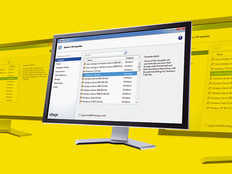What is Virtualization: A Guide to Virtualization's Benefits and Types
Virtualization is a hot topic in IT circles right now, but it's often misunderstood by many in the higher education community. The term is broad, so we’ll break it down and demystify the topic.
Technically, virtualization is the “creation of a virtual (rather than actual) version of something, such as an operating system, a server, a storage device or network resources” according to SearchServerVirtualization. In the CDW•G reference guide on Virtualization and Infrastructure Optimization, it’s defined as “a method of decoupling an application and the resources required to run it — processor, memory, operating system, storage and network access — from the underlying hardware host.” The important takeaway is that multiple resources can be accessed from a single server, resulting in fewer servers, less energy consumption and less maintenance.
What is the difference between virtualization and cloud computing?
While these two IT terms are often substituted for one another, there is a very real difference: Virtualization is part of a physical infrastructure, while cloud computing is a service. There is also a significant cost difference: Those who use virtualization encounter high upfront costs but save money in the long run; those who opt for cloud computing typically pay a subscription fee based on how much they use. If your user base grows, or consumers eat up more resources, your fees could increase over time.
Another important distinction is that virtualization can be a method for delivering a private cloud, but it doesn’t work the other way around. ZDNet clears it up: “Every square is a rectangle but not every rectangle is a square. Every cloud is composed of virtual infrastructure but not every virtual infrastructure is part of a cloud.”
Different Categories of Virtualization
Virtualization is an umbrella term for many different types of computing:
- Hardware Virtualization: This allows one server to run multiple operating systems at the same time, decreasing the number of servers needed to power a workforce.
- Software Virtualization: If you’ve ever booted your Mac in Windows, or vice versa, you were virtualizing your software. This typically happens on individual computers, not entire networks.
- Desktop Virtualization: VMware calls this VDI, and although that is their proprietary system, the concept of desktop virtualization is not limited to any single company. In this scenario, each computer’s preferences, OS, application and files are hosted somewhere other than the local machine. This has a number of benefits, both for end users and for IT departments.
- Storage Virtualization: This is the consolidation of data in a central location, where multiple users can access it. It allows for the reduction in duplicated data and potentially fewer servers.
To learn more about virtualization in all its forms, download our Virtualization and Infrastructure Optimization reference guide. Additionally, here are a few stories that show how virtualiztion benefits IT workers and end-users.








